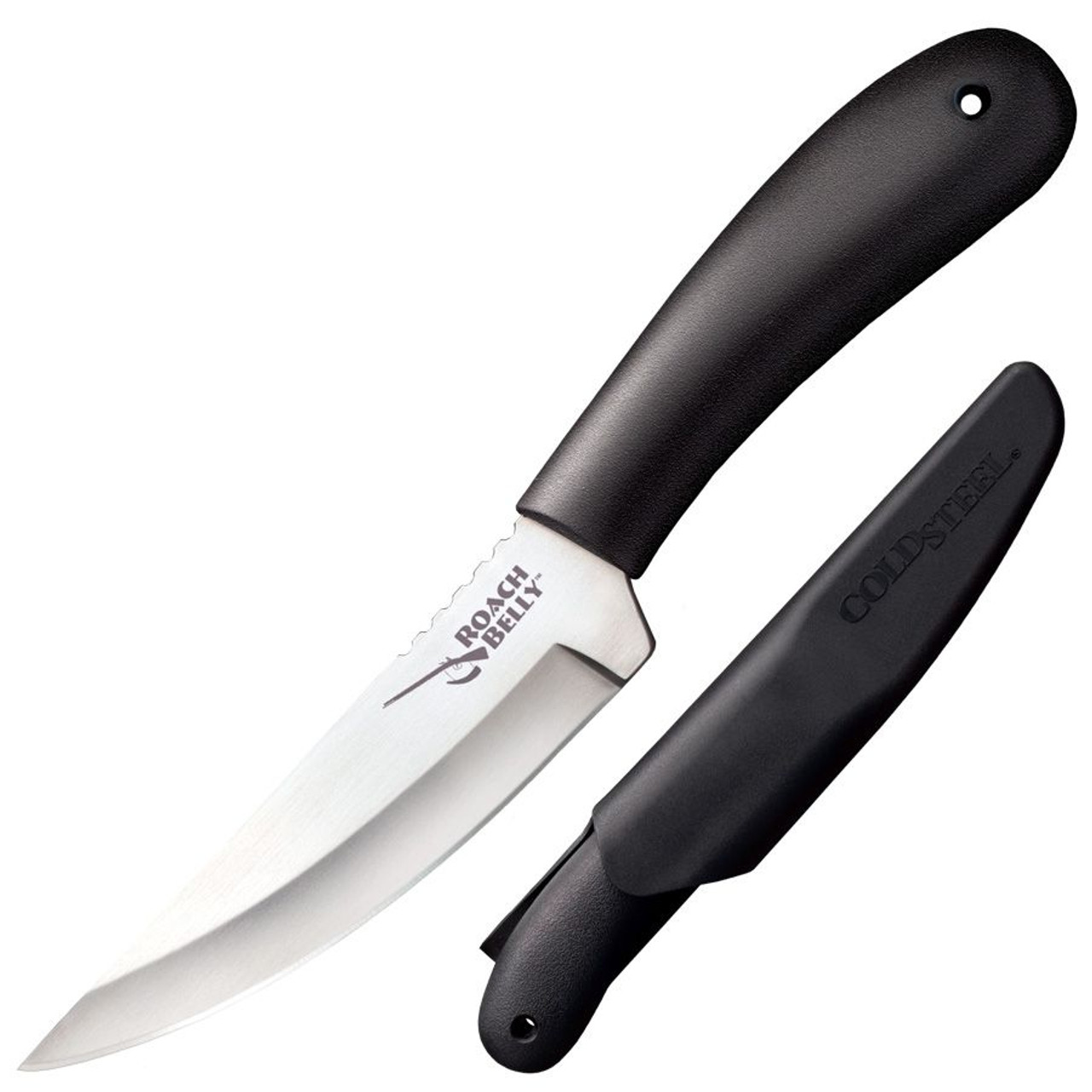His book Woodcraft and Camping is excellent. Blade 4 38 - Handle 4 78 - Overall 9 34 including forged lanyard - Width 1 14 -.
The sheath for this knife is sold separately right here.

Roach belly knife history. The blade of the knife looks like a belly the blades spine is close to straight but not always straight. The historical Roach Belly knife was a short blade with a pronounced upswept curve and a sharp point. The design has stood the test of time.
You can download a free copy from Project Gutenberg. The historical Roach Belly knife was a short blade with a pronounced upswept curve and a sharp point. No doubt that this would do very well in any fur bearer skin with its slim blade.
K431 Roach Belly Knife With a Forged Lanyard. Each knife comes fully- equipped with a heavy leather belt sheath. It was most likely named after the common Roach Fish which had a similarly round curving belly.
A typical English kitchen knife of the period it features a full tang with integral bolsters antiqued bone scales and a richly browned 5 carbon steel blade. It was known in 17th century Britain and quite common in the American Colonies because it. KNIFE-RB-D Roach Belly Knife Damascus with Bone Scales 5-14 blade with leather sheath.
A smooth Oak handle is attached by three solid brass pins. The handles also have a nice antiqued patina due to the dark stain that is applied to them. 9 overall and complete with heavy leather sheath decorated with cross-.
This Roach Belly with its curved cutting edge was an extremely popular style sold by most North American fur trading companies in the 17th and 18th centuries. Hand-Forged Roach Belly Knife. Hard PlasticGot mine herehttpswwww.
4 124116 Krupp Stainless SteelOverall. KNIFE-ROACH-4 English Roach Belly Knife 4 blade replica 1750 - 1790 era Trade Knife made in the USA. The blade is usually a longer profile rather than a short profile.
The handles are made from curly maple and fit your hand perfectly. Historically the Roach-Bellied knife was a short blade with a pronounced upswept curve and a sharp point that saw popularity in 17th century Britain and the American Colonies. It was most likely named after the common Roach Fish which had a similarly round curving belly.
This Roach Belly curved cutting edge knife of the 17th and 18th centuries is of the type sold by the earliest traders. This knife design pays homage to the Hudson bay region roach belly knife a style with a large belly and classic looks that is very popular with the muzzleloadingblackpowder community and period knifemakers. Roach Belly Knifewith Sheath.
The blade is about 5 inches long with the overall length being approximately 9 12. Is a manufacturer and retailer of quality reproduction 18th and early 19th Century clothing and personal accessories. Features antiqued bone scales a full tang and carbon steel blade.
This type of knife appeared in America heavily during the 1800s early 1900s. The Cold Steel Roach Belly costs less than 20 and with 20 minutes of modification with basic tools it can be a much more effective fighting and utility blad. Townsend Son Inc.
9 12 inch overall 5 12 inch blade. The historical Roach Belly knife was a short blade with a pronounced upswept curve and a sharp point. Cold Steel interpretation of this knife is a nod to the black powder community which.
My research says this type of blade may date back as far as the 14th century. It was most likely named after the common Roach Fish which had a similarly round curving belly. The knife itself has a.
The Condor Nessmuk is patterned after the knife designed by the well known outdoorsman George Washington Sears in the late 1800s. It was most likely named after the common Roach fish which had a similarly round curving belly. Roach Belly Knife This Roach Belly with its curved cutting edge was an extremely popular style sold by most North American fur trading companies in the 17th and 18th centuries.
1095 high carbon steel. Historically the Roach-Bellied knife was a short blade with a pronounced upswept curve and a sharp point that saw popularity in 17th century Britain and the American Colonies. Cutting edge tempered to Rc 59-60.
KNIFE-ROACH-HB Hudsons Bay Company Trade Knife 5-12 blade replica 1750 - 1790 era Trade Knife made in the USA. The Roach Belly shape of the blade easily dates back to the 18th Century. A typical English kitchen knife of the period.
It was known in 17th century Britain and the American colonies. The knife design boasts a fine point at the end that proved. It was known in 17th century Britain and quite common in the American Colonies because it was inexpensive and versatile.
It was most likely named after the common Roach Fish which had a similarly round curving belly. Skillfully made reasonably priced satisfaction guaranteed. Good budget field knifeSpecsBlade.
The Lewis Clark is 9 in length and has four brass pins while the Roach Belly is 9-12 with six pins. We service the living history community historic sites museums and theatrical motion picture and television production companies. It might have been named after the Roach fish which had a similarly round curving bellyThe pattern was known in 17th century England and was quite common in the American Colonies because it was inexpensive and versatile.
The historical Roach belly knife was a short blade with a pronounced upswept curve and a sharp point.
